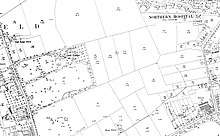Samuel Sugden (merchant)


Samuel Sugden (c. 1800 - 12 October 1896) was an English merchant from Leeds who built Oak Lodge in north London, after which the district of Oakwood is named.
Early life and family
Samuel Sugden was born around 1800 in Leeds, Yorkshire.[1] He married Emma Elizabeth Linsell (died 1874) at the Weld Chapel, Southgate, in 1848.[2] They had daughters, Elizabeth, Emily, Emma, Annie, Clara, and Florence, and sons Charles, Henry, Albert and Edwin. In 1851 the family lived at Oak Fields Villa, Hornsey, Middlesex;[1] in 1861 they were at Chase Side, Southgate;[3] and in 1871 at Edmonton.[4]
His wife Emma died in 1874 and is remembered in a 3-light window in the Lady Chapel at St Pauls Church, Winchmore Hill. His daughter Annie, who died in 1939, also has a window to her memory in the chapel.[5]
Career
In both the 1851 and 1861 censuses, Sugden's occupation was recorded as "warehouseman",[1][3] however, he was able to support a large family with four servants and in 1861 employed a governess.[3] By the time of the 1871 census he was described as a "merchant".[4]
In the late 1860s he purchased a farm and farmhouse on land that was formerly part of Enfield Chase, the royal hunting ground.[5] An Oak Farm is mentioned on an 1822 Ordnance Survey map in that location.[6] Using the services of local builder John Wilkinson, whose office was near the Cherry Tree pub in Southgate, he rebuilt the house into a much more substantial residence known as Oak Lodge with a walled garden, orchard, ice well, and a collection of outbuildings.[7] He made his own gas in an outbuilding at the lodge[5] and a gasometer is shown on contemporary Ordnance Survey maps.
He ran Chase Farm in Chase Road, approximately where the modern Merrivale road is, that was later known as Oak Lodge Farm.[5]
Death and legacy
Sugden died on 12 October 1896 leaving his estate to trustees. By that time he was known as Samuel Sugden the elder. Probate was granted in London to "Samuel Sugden gentleman, Charles Alfred Sugden merchant and Charles Eustace-Wilson gentleman" on an estate of £140,034, resworn in 1898 in the amount of £139,005.[8] Charles Alfred Sugden was Samuel's son, Charles Eustace-Wilson was a solicitor, and the relationship of the living Samuel Sugden to the deceased is unknown. In July 1897, Oak Lodge was advertised for sale by auction in The Times.[9]
Oak Lodge and its outbuildings were demolished just after the end of the First World War and in 1927 Southgate Urban District Council purchased 50 acres from Sugden's executors[10] which it combined with 8.5 acres it purchased from the Vicar of Enfield to form Oakwood Park.[5] Sugden's ice well still exists in the park.[11]
References
- 1 2 3 Samuel Sugden England and Wales Census, 1851. FamilySearch. Retrieved 10 August 2017. (subscription required)
- ↑ Samuel Sugden. FamilySearch. Retrieved 10 August 2017. (subscription required)
- 1 2 3 Samuel Sugden England and Wales Census, 1861. FamilySearch. Retrieved 10 August 2017. (subscription required)
- 1 2 Samuel Sugden England and Wales Census, 1871. FamilySearch. Retrieved 10 August 2017. (subscription required)
- 1 2 3 4 5 Dumayne, Alan. (1987) Southgate: A glimpse into the past. Alan Dumayne, London, 1987. pp. 65-66. ISBN 0951228609
- ↑ Mills, A.D. (2001) A Dictionary of London Place-Names. Oxford: Oxford University Press. p. 168. ISBN 978-0198609575
- ↑ Mason, Tom. (1947) The Story of Southgate. Enfield: Meyers Brooks. p. 56.
- ↑ 1896 Probate Calendar
- ↑ Advertising, The Times, 31 July 1897, p. 18.
- ↑ Edmonton: Growth after 1851. British History Online. Retrieved 9 August 2017.
- ↑ Oakwood Park, Enfield, (also known as Enfield Chase), London, England. Parks & Gardens UK, 25 February 2014. Retrieved 9 August 2017.
External links

